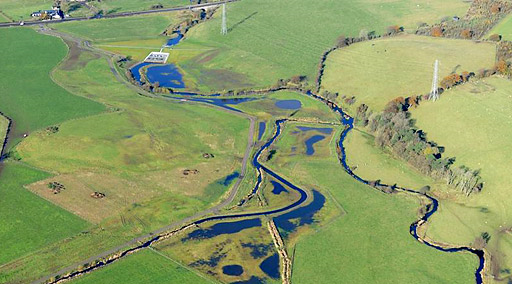Seasonal streams or intermittent rivers are rivers for which surface water ceases to flow at some point in space and time. They comprise a large proportion of the global river network and are characterized by dynamic exchanges between terrestrial and aquatic habitats. These habitats support aquatic, semi-aquatic, and terrestrial biota. Seasonal streams provide essential ecosystem services to society, including flood control and irrigation. The abundance and distribution of seasonal streams, and their natural intermittent flow regimes, are being altered by climate change, water abstraction and inter-basin transfers. Despite their values and ongoing alterations, seasonal streams are chronically under-studied and protective management is inadequate.
Restoring and reconnecting seasonal streams with the river consists in, therefore favouring the overall functioning of the river by restoring lateral connectivity, diversifying flows and ensuring the proper functioning of these seasonal streams for a better water retention during floods.

Tributary useful during flooding, (Scotland, UK)
| Benefits | Level |
|---|---|
|
PO1 - Improving status of biology quality elements
|
Medium
|
|
PO2 - Improving status of physico-chemical quality elements
|
Medium
|
|
PO3 - Improving status of hydromorphology quality elements
|
Medium
|
|
PO4 - Improving chemical status and priority substances
|
High
|
|
PO5 - Improving quantitative status
|
Medium
|
|
PO6 - Improving chemical status
|
Medium
|
|
PO7 - Prevent surface water status deterioration
|
Medium
|
|
PO8 - Prevent groundwater status deterioration
|
Low
|
|
PO9 - Take adequate and co-ordinated measures to reduce flood risks
|
High
|
|
PO10 - Protection of important habitats
|
High
|
|
PO11 - Better protection for ecosystems and more use of Green Infrastructure
|
High
|
|
PO12 - More sustainable agriculture and forestry
|
Low
|
|
PO13 - Better management of fish stocks
|
Medium
|
|
PO14 - Prevention of biodiversity loss
|
High
|
|
ES1 - Water storage
|
Medium
|
|
ES2 - Fish stocks and recruiting
|
Medium
|
|
ES3 - Natural biomass production
|
Low
|
|
ES4 - Biodiversity preservation
|
High
|
|
ES5 - Climate change adaptation and mitigation
|
Medium
|
|
ES6 - Groundwater/aquifer recharge
|
Medium
|
|
ES7 - Flood risk reduction
|
Medium
|
|
ES8 - Erosion/sediment control
|
High
|
|
ES9 - Filtration of pollutants
|
Medium
|
|
ES11 - Aesthetic/cultural value
|
Medium
|
|
BP1 - Store runoff
|
High
|
|
BP2 - Slow runoff
|
High
|
|
BP3 - Store river water
|
High
|
|
BP4 - Slow river water
|
High
|
|
BP5 - Increase evapotranspiration
|
Low
|
|
BP6 - Increase infiltration and/or groundwater recharge
|
High
|
|
BP7 - Increase soil water retention
|
Medium
|
|
BP8 - Reduce pollutant sources
|
Low
|
|
BP9 - Intercept pollution pathways
|
Medium
|
|
BP10 - Reduce erosion and/or sediment delivery
|
High
|
|
BP11 - Improve soils
|
Low
|
|
BP12 - Create aquatic habitat
|
Low
|
|
BP13 - Create riparian habitat
|
High
|
|
PO14 - Prevention of biodiversity loss
|
Low
|
|
BP15 - Enhance precipitation
|
Low
|
|
BP16 - Reduce peak temperature
|
Low
|
|
BP17 - Absorb and/or retain CO2
|
Low
|
